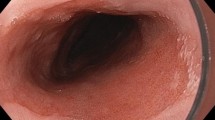Abstract
Dysphagia is an alarming symptom that raises the possibility of stricture or malignancy. This study compares the prevalence and severity of dysphagia symptoms in subjects with or without gastroesophageal reflux (GERD). In a population-based study, 500 residents of Cologne between the ages of 20 and 90 years [232 (46%) males and 268 (54%) females] were randomly selected from the city register and sent questionnaires with reflux-related questions. Two hundred sixty-eight replies (54%) were accepted into the study. Of these, 45% were men with a median age of 58 years. The median female age was 54 years. Thirty-four percent of the respondents (n = 92) admitted having heartburn symptoms. There was no significant gender-based difference. There was little variation in reflux frequency between individual age groups. Twenty-three (25%) of the 92 respondents with reflux reported symptoms more than twice per week. Forty-five percent of this “reflux” group took medications for their heartburn. Swallowing difficulties, predominantly mild, were reported in 11.3% of the respondents. Dysphagia was significantly increased in the reflux group (28%) versus the normal group (3%) (p < 0.001). Sixteen percent of respondents with mild and 65% of those with moderate to severe reflux symptoms reported additional dysphagia symptoms (p < 0.001). Swallowing problems are common in patients with GERD. Approximately two thirds of patients with long-term and severe reflux symptoms also have dysphagia symptoms. Dysphagia should always be investigated by a physician.

Similar content being viewed by others
References
Vakil N, Traxler B, Levine D. Dysphagia in patients with erosive esophagitis: prevalence, severity, and response to proton pump inhibitor treatment. Clin Gastroenterol Hepatol 2004;2:665–668.
Leers J, Bollschweiler E, Holscher A. Symptoms in patients with adenocarcinoma of the esophagus. Z Gastroenterol 2005;43:275–280.
Dent J. Gastro-oesophageal reflux disease. Digestion 1998;59:433–445.
Bardhan KD, Royston C, Nayyar AK. Reflux rising! A disease in evolution? Gastroenterology 2000;118:A478–A478.
Bardhan KD, Royston C, Nayyar AK. Reflux rising! An essay on witnessing a disease in evolution. Dig Liver Dis 2006;38:163–168.
Ronkainen J, Aro P, Storskrubb T, Johansson S, Lind T, Bolling-Sternevald E, Graffner H, Vieth M, Stolte M, Engstrand L, Talley N, Agreus L. High prevalence of gastroesophageal reflux symptoms and esophagitis with or without symptoms in the general adult Swedish population: a Kalixanda study report. Scand J Gastroenterol 2005;40:275–285.
Chiocca J, Olmos J, Salis G, Soifer L, Higa R, Marcolongo M. Prevalence, clinical spectrum and atypical symptoms of gastro-oesophageal reflux in Argentina: a nationwide population-based study. Aliment Pharmacol Ther 2005;22:331–342.
Nocon M, Labenz J, Willich SN. Lifestyle factors and symptoms of gastro-oesophageal reflux - a population-based study. Aliment Pharmacol Ther 2006;23:169–174.
Dent J, El-Serag H, Wallander M, Johansson S. Epidemiology of gastro-oesophageal reflux disease: a systematic review. Gut 2005;54:710–717.
El-Serag H, Petersen N, Carter J, Graham D, Richardson P, Genta R, Rabeneck L. Gastroesophageal reflux among different racial groups in the United States. Gastroenterology 2004;126:1692–1699.
Ponce J, Vegazo O, Beltran B, Jimenez J, Zapardiel J, Calle D, Piques JM. Prevalence of gastro-oesophageal reflux disease in Spain and associated factors. Aliment Pharmacol Ther 2006;23:175–183.
Wong BCY, Kinoshita Y. Systematic review on epidemiology of gastroesophageal reflux disease in Asia. Clin Gastroenterol Hepatol 2006;4:398–407.
Cho YS, Choi MG, Jeong JJ, Chung WC, Lee IS, Kim SW, Han SW, Choi KY, Chung IS. Prevalence and clinical spectrum of gastroesophageal reflux: A population-based study in Asan-si, Korea. Am J Gastroenterol 2005;100:747–753.
Kawashima K, Motohashi Y, Fujishima I. Prevalence of dysphagia among community-dwelling elderly individuals as estimated using a questionnaire for dysphagia screening. Dysphagia 2004;19:266–271.
Hollenz M, Stolte M, Labenz J. [Prevalence of gastro-oesophageal reflux disease in general practice]. Dtsch Med Wochenschr 2002;127:1007–1012.
Paciaroni M, Mazzotta G, Corea F, Caso V, Venti M, Milia P, Silvestrelli G, Palmerini F, Parnetti L, Gallai V. Dysphagia following stroke. Eur Neurol 2004;51:162–167.
Lagergren J, Bergström R, Lindgren A, Nyren O. Symptomatic gastroesophageal reflux as a risk factor for esophageal adenocarcinoma. N Engl J Med 1999;18:825–831.
Bollschweiler E, Wolfgarten E, Gutschow C, Holscher AH. Demographic variations in the rising incidence of esophageal adenocarcinoma in white males. Cancer 2001;92:549–555.
Pera M. Trends in incidence and prevalence of specialized intestinal metaplasia, Barrett’s esophagus, and adenocarcinoma of the gastroesophageal junction. World J Surg 2003;27:999–1008; discussion 1006–1008.
Carlsson R, Dent J, Bolling-Sternevald E, Johnsson F, Junghard O, Lauritsen K, Riley S, Lundell L. The usefulness of a structured questionnaire in the assessment of symptomatic gastroesophageal reflux disease. Scand J Gastroenterol 1998;33:1023–1029.
Isolauri J, Laippala P. Prevalence of symptoms suggestive of gastroesophageal reflux disease in an adult population. Ann Med 1995;27:67–70.
Terry P, Lagergren J, Wolk A, Nyren O. Reflux-inducing dietary factors and risk of adenocarcinoma of the esophagus and gastric cardia. Nutr Cancer 2000;38:186–191.
Nilsson M, Johnsen R, Ye W, Hveem K, Lagergren J. Prevalence of gastro-oesophageal reflux symptoms and the influence of age and sex. Scand J Gastroenterol 2004;39:1040–1045.
Valle C, Broglia F, Pistorio A, Tinelli C, Perego M. Prevalence and impact of symptoms suggestive of gastroesophageal reflux disease. Dig Dis Sci 1999;44:1848–1852.
Bretagne JF, Richard-Molard B, Honnorat C, Caekaert A, Barthelemy P. Gastroesophageal reflux in the French general population: national survey of 8000 adults. Presse Med 2006;35:23–31.
Author information
Authors and Affiliations
Corresponding author
Rights and permissions
About this article
Cite this article
Bollschweiler, E., Knoppe, K., Wolfgarten, E. et al. Prevalence of Dysphagia in Patients with Gastroesophageal Reflux in Germany. Dysphagia 23, 172–176 (2008). https://doi.org/10.1007/s00455-007-9120-5
Received:
Accepted:
Published:
Issue Date:
DOI: https://doi.org/10.1007/s00455-007-9120-5




